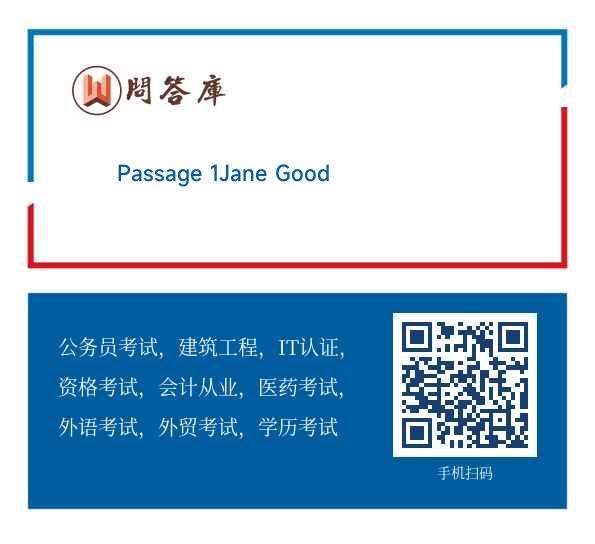Passage 1Jane Goodall was already on a London
问题详情
Passage 1
Jane Goodall was already on a London dock in March 1957 when she realized that her passport was missing. In just a few hours, she was due to depart on her first trip to Africa. A school friend had moved to a farm outside Nairobi and, knowing Goodall’s childhood dream was to live among the African wildlife, invited her to stay with the family for a while. Goodall, then 22, saved for two years to pay for her passage to Kenya: waitressing, doing secretarial work, temping at the post office in her hometown, Bournemouth, on England’s southern coast. Now all this was for naught, it seemed.
It’s hard not to wonder how subsequent events in her life — rather consequential as they have turned out to be to conservation, to science, to our sense of ourselves as a species — might have unfolded differently had someone not found her passport, along with an itinerary from Cook’s, the travel agency, folded inside, and delivered it to the Cook’s office. An agency representative, documents in hand, found her on the dock. “Incredible,” Goodall told me last month, recalling that day. “Amazing.”
Within two months of her arrival, Goodall met the paleontologist Louis Leakey — Nairobi was a small town for its white population in those days — and he immediately offered her a job at the natural-history museum where he was curator. He spent much of the next three years testing her capacity for repetitive work.
He believed in a hypothesis first put forth by Charles Darwin that humans and chimpanzees share an evolutionary ancestor. Close study of chimpanzees in the wild, he thought, might tell us something about that common progenitor. He was, in other words, looking for someone to live among Africa’s wild animals. One night, he told Goodall that he knew just the place where she could do it: Gombe Stream Chimpanzee Reserve, in the British colony of Tanganyika (now Tanzania).
In July 1960, Goodall boarded a boat and after a few hours motoring over thewarm, deep waters of Lake Tanganyika, she stepped onto the pebbly beach at Gombe. Her finding, published in Nature in 1964, that chimpanzees use tools — extracting insects from a termite mound with leaves of grass — drastically and forever altered humanity’s understanding of itself; man was no longer the natural world’s only user of tools.
After two and a half decades of living out her childhood dream, Goodall made an abrupt career shift, from scientist to conservationist.请帮忙给出正确答案和分析,谢谢!
参考答案
正确答案:
1957年3月,简古多尔已站在伦敦的一个码头上,突然发觉自己的护照不见踪影了。再过几个小时,她该出发,踏上第一次去非洲的旅程。她的一位老同学移居内罗毕郊外的一座农场,知道古多尔自幼梦想与非洲的野生动物为伴,因此邀请她到家中小住。时年22岁的古多尔花了两时时间积攒去肯尼亚的旅费:她当过服务员,做过文秘,还在家乡(英格兰南部海岸伯恩茅斯)的邮局干过临时工。现在看起来,这一切都白费了。
令人不禁感到惊讶的是,虽然她后来的生活轨迹证明对环保工作,对科学以及对我们自身作为物种的认识上都至关重要,若不是有人捡到护照和夹在里面的库克旅行社的行程表,并将其交到旅行社办事处,这一切都将会不可能了。旅行社的一位代表拿着这些材料在码头上找到了她。上个月,她回想起那天发生的事时对我说:“太不可思议了,真是一个惊喜。”
古多尔到了肯尼亚后,不到两个月,就遇见了古生物学家路易斯李基。对当地的白人来说,内罗毕当时就是个小镇。李基在自然史博物馆当馆长。马上就在博物馆给她安排了一个工作。接下来的三年中,他花了很多时间考查她有没有反复做一件工作的能力。
路易斯李基相信达尔文首提的一项假设:人类和黑猩猩是由一个共同祖先进化而来的。他认为,如果仔细观察野外黑猩猩,我们就能进一步了解共同祖先。换言之,他在物色一个人,能和非洲的野生动物一起生活。一天晚上,他对古尔多说,他知道有个地方正好让她做这项工作。贡贝河黑猩猩保护区,地点在英国殖民地坦噶尼喀(即今坦桑尼亚)
1960年7月,古尔多先乘船,然后乘摩托快艇在坦噶尼喀温暖的水面上航行数小时后,来到贡贝,在布满鹅卵石的湖岸上下了船。(2分)
1964年,她的研究成果在《自然》杂志上发表,该成果证明黑猩猩会使用工具,用草叶把白蚁堆里的白蚁掏出来。这彻底改变了人类对自身的认识:人类不再是大自然中唯一会使用工具的物种。古尔多用25年实现了自己儿时梦想后,突然改行,不当科学家,而当了一名环保工作者。
